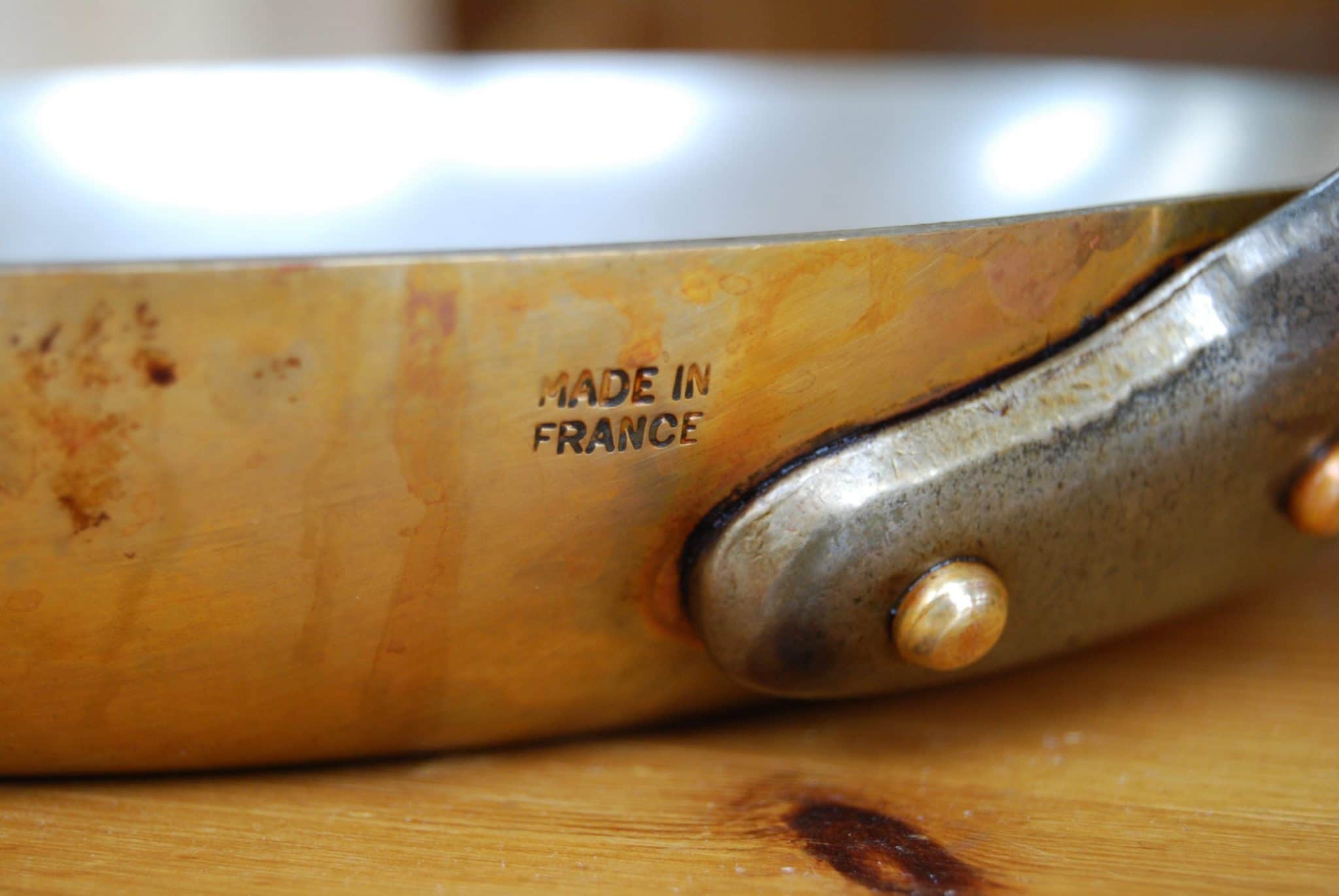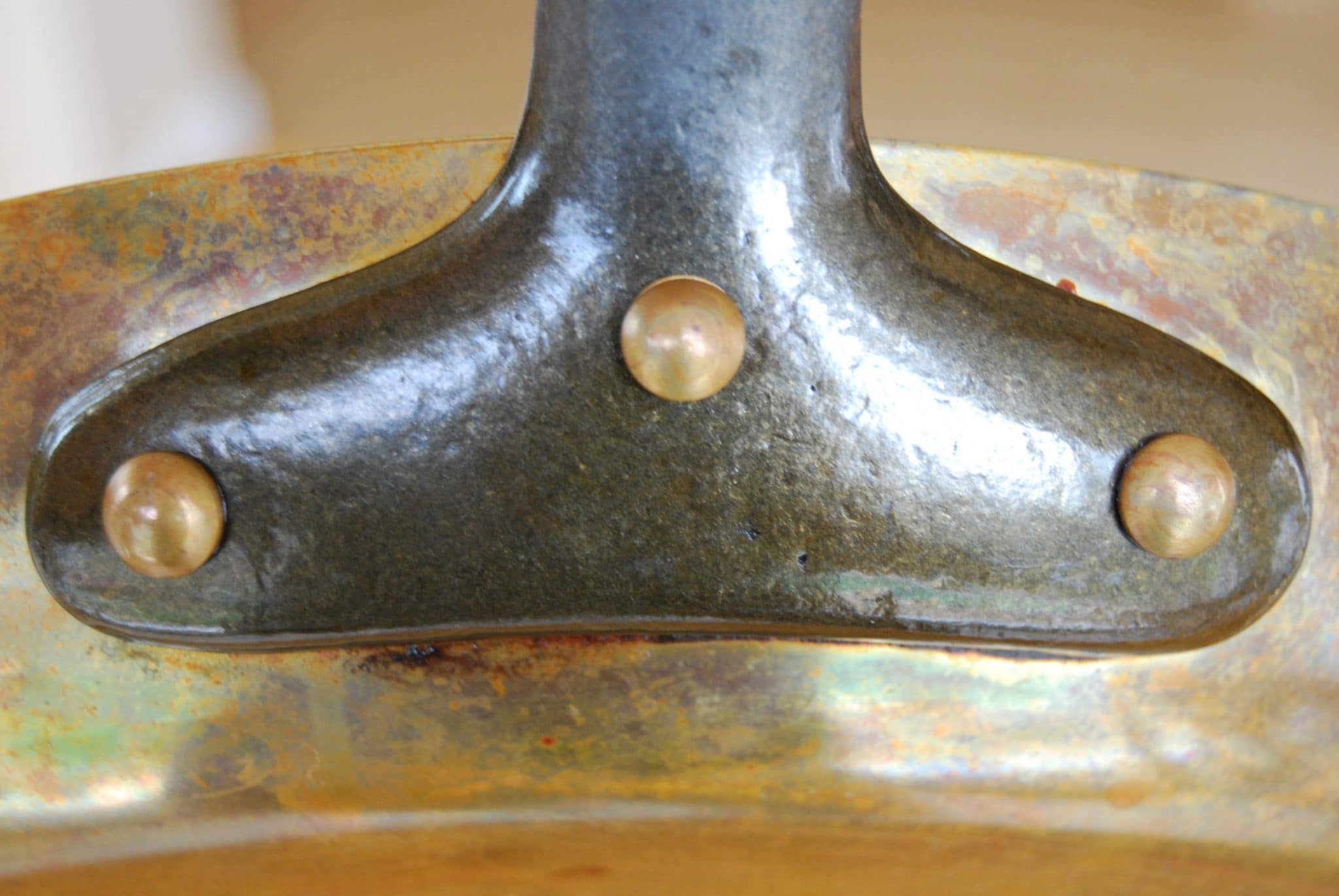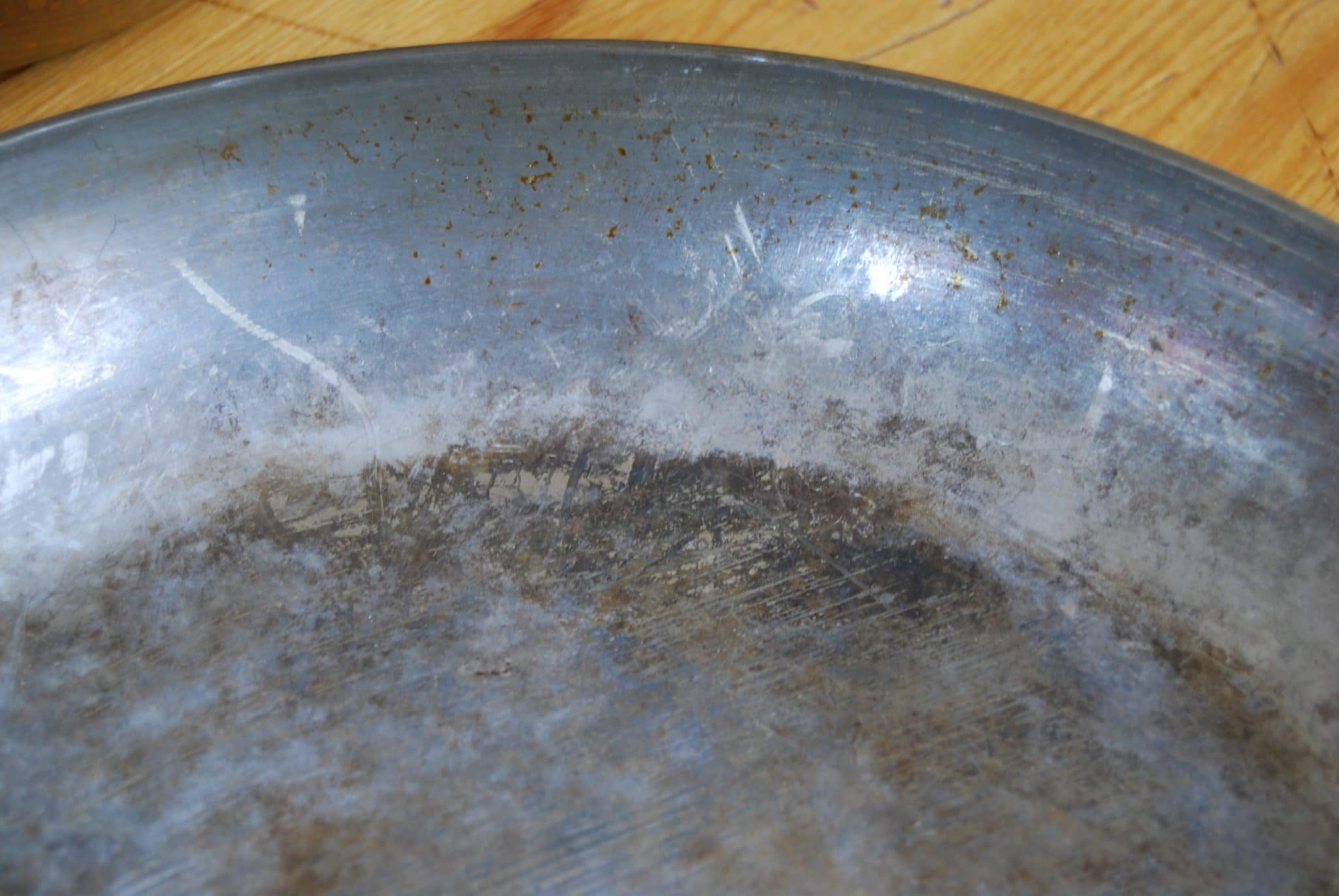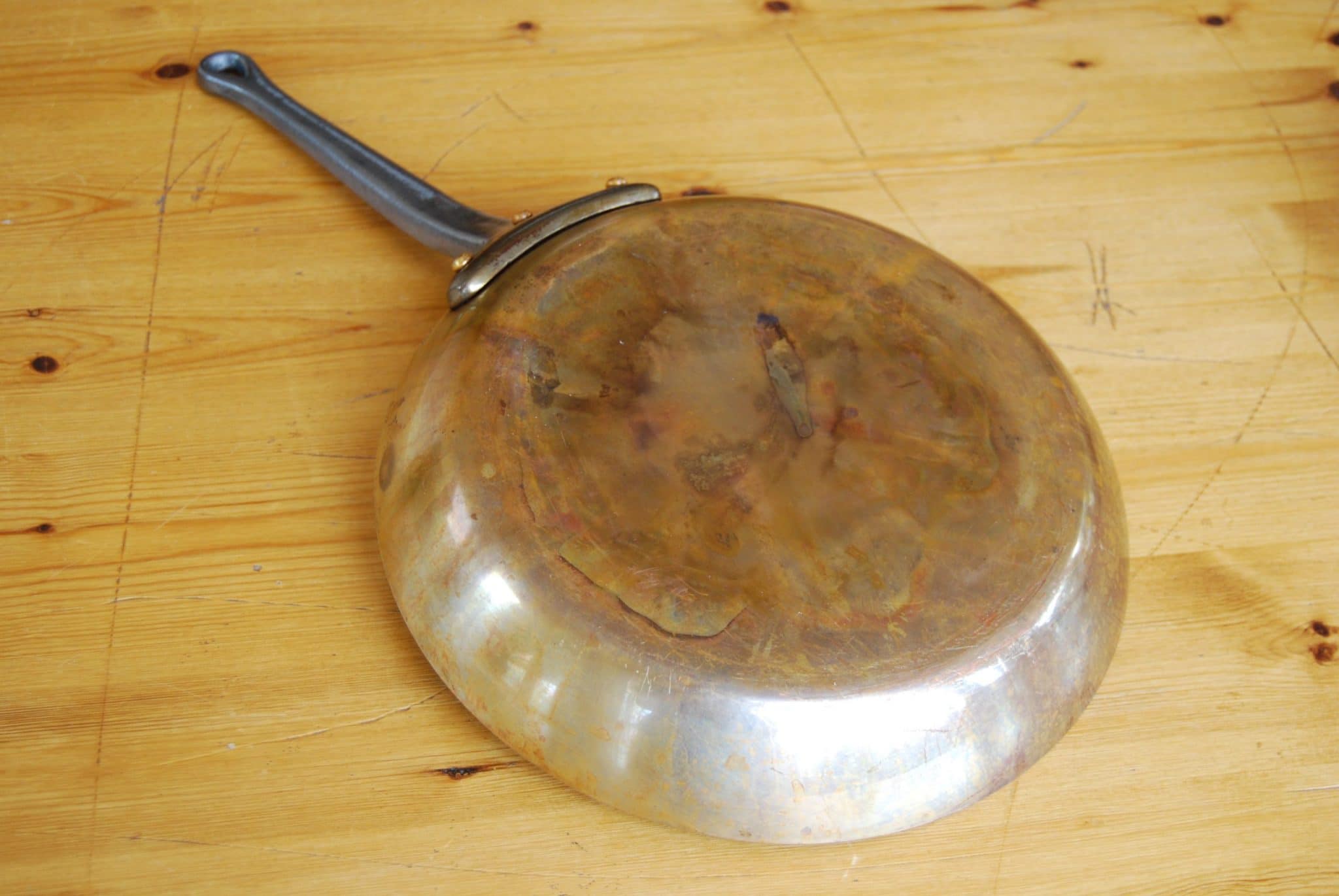Yes, I use tinned skillets, and I use them a lot. Meet two of my favorite working pans.

| Type | Two tin-lined skillets in smooth finish with iron handles fastened with three copper rivets |
|
| French description | Deux poêles étamées avec queues de fer munies avec trois rivets en cuivre |
|
| Dimensions | 26cm diameter by 5cm tall (10.2 inches by 2 inches) |
31cm diameter by 5.5cm tall (12.2 inches by 2.2 inches) |
| Thickness | 2.5mm | 2.5mm |
| Weight | 1900g (4.2 lbs) |
2586g (5.7 lbs) |
| Stampings | MADE IN FRANCE | MAUVIEL 1830 FRANCE |
| Maker and age estimate | Mauviel; 1990s to 2000 | Mauviel; 2007 to 2011 |
| Source | Harestew | |
There are two schools of thought with tin-lined copper skillets. One school of thought is that because skillets are designed for high-heat cooking, putting tin into a skillet is just setting you up to melt it, or at the very least some unsightly smearing and bubbling. The other school of thought is that tin’s innate benefits are ideal for skillets and tin’s thermal limitations can be managed just fine.
Guess which school I’m in.
Tin is a great cooking surface for a skillet because it’s innately low-stick. It’s not non-stick like a PTFE coating, but it releases food much more easily than stainless steel. This kind of performance is great for a skillet, which is essentially a shallow heating platform designed to encourage the low-moisture Maillard reaction to brown food. Tin’s easy cleanup is also a blessing.
But compared to cast iron or steel, tin is not a high-heat cooking surface. Tin melts at 450°F (232°C); this is plenty hot for most cooking tasks, but such things as broiling at 500°F (260°C) and flash searing risk softening the tin. (The result can be smearing or bubbling, but these are cosmetic issues and nothing happens to the copper itself.) A tinned skillet will never be a “heat it and forget it” pan, which will be an adjustment for people who are accustomed to preheating skillets to screaming hot temperatures.
I know, because I was one of those people. I didn’t think I wanted a tinned skillet. When I got these, I didn’t think I’d really use them, but when I did, I loved how they performed.
Now, granted, these are special. (Well, at least to me.) During the modern era of manufacture, Mauviel settled into making skillets at 1.5mm, 2mm, and 2.5mm thickness, but the vast majority of skillets I see on eBay and Etsy are 2mm. These two are both 2.5mm, which in my experience is harder to find. (I have a 3mm skillet that I strongly suspect is Mauviel but it’s the only one I’ve ever seen.) They’ve also got cast iron handles, which I prefer for their improved heat resistance over brass.
Skillets are not complicated pieces of kit and at first glance these two look identical. They were manufactured in different decades and the assembly technology was the same; the exterior rivet finishes look a little different to my eye but that could be just from variances in production runs of the part.
The earlier of the two skillets is the 26cm. Its only marking is the MADE IN FRANCE stamp that Mauviel began to use in the 1960s. Harestew tells me this pan is from the 1990s.




The larger 31cm diameter skillet has a different logo with the words “Mauviel 1830 France,” indicating that it was made after 2007 when Mauviel adopted the “Mauviel 1830” branding. The simplicity of the stamp style and the old-style iron handle tell me that this was made at the start of that period; Mauviel’s stamp style subsequently changed and the handle baseplate was redesigned. I don’t know exactly when that was, but I would hazard that this pan was made soon after 2007 and prior to about 2010.




These are working pans. This is what tin looks like when you use it. That brown stuff is seasoning, like on a cast iron pan. You don’t need to season tin as you do cast iron or carbon steel because tin is naturally low-stick, but tin will pick up a seasoning layer with use. This seasoning helps with food release just as it does on cast iron and steel; I could clean it off with a baking soda boil but I choose to leave it in place.


The marks that look like scratches up the sides are smear marks in the tin. This skillet got hot, and the tin on the sides with no food or oil contact got the hottest. Those marks are from me moving a wooden spoon or rubber spatula around in the pan; the tin up the sides was hot enough to melt a little, and I left some wipe marks. These don’t bother me in the least.

This is how copper tarnishes when it’s heated, washed, dried, and heated again — look how yellowish it gets. Copper under heat can turn a rainbow of colors and I call this brassy tone the “yellow flag” — it tells me that this pan has gotten up to 400°F (204°C) or hotter, into the zone when tin starts to soften. This is to be accepted on a skillet like this, but if I see this color on a thicker sauté pan or rondeau (and I have!) I know that I may be taking the temp up a bit high for the kind of cooking it’s designed for. But again, on a skillet like this, the yellow flag is not a big deal to me.


My goal with this working pans series is to encourage you to embrace the changes in appearance in your copper and tin as you use it, even the little smears and bubbles. It’s disconcerting for people used to working with stainless steel to see surface discoloration and smear marks on cookware; I know anecdotally that a lot of people bought Williams-Sonoma tinned copper, used it once, and returned it because they thought the pan was defective. (Thanks to all those guys, by the way, for helping to push fabulous thick copper onto the resale market!) I’ve come to understand that smears and bubbles are cosmetic surface flaws, and brown patches are seasoning that helps the pan perform, and I leave them be.

I really enjoy these skillets and they’re going to serve me for decades.






As a general rule, people who love tin-lined skillets are both very brave and very good-looking. Being neither handsome nor brave, I usually reach for heavy 3mm carbon steel or 5mm aluminum.